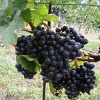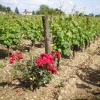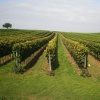




Lebanon - a country of contrasts
It was dark by the time we landed in Beirut and the pre arranged taxi whisked us away from the capital over the snow capped mountains to our first destination, the charming Massabki Hotel in the town of Chtaura in the western Bekaa Valley.
Lebanon is a small country, you can ski in the morning and be on the beach in the afternoon. After a thin Mediterranean coastal strip, the Mount Lebanon range rises to height of up to 10000 feet before falling again to form the narrow Bekaa Valley and then rising again for the anti Lebanon Mountains and the Syrian border beyond.
The fertile Bekaa Valley floor lies at around 1000 metres with some terraced vineyards higher still. The combination of altitude, limestone soils and large difference between day and night time temperatures all assist in providing ideal grape growing conditions. Irrigation comes from snow melt.
Grape growing and wine making is far from new to Lebanon, it can be traced to around 7000BC making Lebanon one of the oldest producing countries. There are currently 33 wineries in Lebanon. Grapes are mainly French in origin – Grenache, Syrah, Cinsault, Carignan, Cabernet Sauvignon, Chardonnay to name a few and I did see the odd vat of Tempranillo.
Day one began with a tour (organised by Nakhal.com) of some of the historical sites. Our guide Hussain was a Sorbonne trained archaeologist and gave us a fascinating insight into the history of the sites. Aanjar is just off the Beirut-Damascus highway and is one of Lebanons five world heritage sites and is from the Umayyad Dynasty. The key roads of this ancient city run north to south and east to west and marked at the crossroads by 4 columns. There are remains of 2 palaces, baths and shops
From Aanjar, we headed north, past armed checkpoints to the stunning Roman city of Baalbek. We stopped to climb the worlds biggest cut stone weighing over 1,000 tonnes. A number of these were used during the building of the temples. The sheer scale of Baalbek is so impressive, Firstly the temple of Venus and then temple of Jupiter, defined by the six remaining Corinthian columns. The Temple of Bacchus is incredibly well preserved.
Following a delicious lunch of meze and grilled meats by the river in Zahle we head to Ksara Winery.
Ksara is the largest and oldest producer in Lebanon. Algerian vines were planted by Jesuit missionaries in 1857. In 1906, the monks discovered a maze of Roman caves. The story goes that a fox had been stealing chickens and was followed to an entrance which lead to the caves which have now been expanded to over 2 km of tunnels providing ideal wine storage conditions.
Chtaura was chosen as our base due to its proximity to a number of wineries and the following morning, we took a short taxi ride to Chateau Ka on the edge of town.
Part of a family run company Kassalty Chtaura who produce RTD’s, juices and syrups, the Chateau Ka wines were re-launched in 2005. The hand -picked vineyards are towards Baalbek. I met with Ghida Kassalty and Burgundy trained wine maker Jean Tannouri and tasted an elegant range of wines.
Massaya is close by. The restaurant has a great reputation, local women cook traditional food. As well as producing wine, like a number of other wineries, Massaya produces the local grape spirit arak and our tour included the stills, the spirit is twice distilled from the local white Obaideh grape and then redistilled with aniseed (the best comes from Syria). In the storage area, the heady scent of the arak maturing in earthenware jars filled the air.
Massaya own their own vineyards and also buy in grapes but control vineyard practices to ensure the quality. The range of wines showed poise and elegance –balanced with good fruit.
Established in 1868 by the Brun family, Domaine Des Tourelles is a 5 minute stroll from the Massabki Hotel (which was once part of the estate). We were shown round by wine maker Faouzi Issa who is as passionate about his wines as he is about preserving the history of the domaine which is now surrounded by the expanding town.
As we tasted the wines in the garden overlooking the vines with the snow capped mountains in the background, the constant beeping of the car horns faded into the distance.
After 2 days in the Bekaa Valley we took the winding road back over the mountains to stay with friends in the residential hillside area of Adma, close to the sprawling resort of Jounieh. At the bottom of the hill overlooking the Mediterranean is the Casino. Its grand interior harks back to the 50’s and 60’s and the walls are adorned with black and white photos of the rich and famous for whom Beirut , often called ‘the Paris of the Middle East’, was their playground.
A short drive away at the top of another steep hill is Ghazir and the 18th century castle that is home to Chateau Musar. Their grapes are grown organically across in the Bekaa Valley. I have mentioned their wines before and they were one of the inspirations for this trip. With Gaston Hochar and wine maker Tarek Sakr who has been at Chateau Musar for 21 years, I reacquainted myself with familiar wines amongst the barrels in the high vaulted cellars. We had an interesting tasting of 2011 single varietal Cinsault, Carignan and Cabernet Sauvignon which gave an indication as to the characters they would impart into the final blend.
Deeper in the cellars amongst sleeping bottles we tasted vintages from 1989 ( Millennium special edition) rich and smoky, full bodied and mature with warm spiced dried fruit and a floral freshness and 1977 with a mix of fresh cherry, maturity and soft end. Recent vintages of Chateau Musar, Hochar and Musar Jeune can be found at high street retailers and independent merchants who may also stock older vintages too.
What a great morning. We then headed 20 minutes up the coast to the attractive historic port of Byblos and overlooking the harbour, had a fabulous seafood lunch at Bab El Mina Restaurant before visiting the Citadel and Crusader church and archaeological ruins then explored the restored souks for fossils and belly dancing scarves.
Before heading to Beirut, we took in the stunning Jeita Grotto, a grand cave system stretching for 2 km and then took Le Teleperique cable car for it’s steep climb in small gondolas from Jounieh to Harissa and the statue of Our Lady of Lebanon.
Our base in Beirut was in the heart of the rebuilt pedestrianised historic downtown area at the Etoile Suites Hotel, moments from the Place de Etoile with the Parliament building and clock tower. Radiating out are streets filled with restaurants and shops and close by the Souks of Beirut –modern, well designed shopping malls with every brand and designer store that even the most ardent shopper would need.
We joined the locals who stroll or run along the Corniche (promenade) past the marina, luxury hotels and apartments which stand alongside the occasional abandoned, bullet hole ridden buildings, a poignant reminder of the civil war and 2006 Israeli shelling.
I am left with a lasting impression of welcoming positive people, great food, beautiful scenery and a complex history. Wines from Lebanon do have their own style, one that is characterised good fruit and elegance and when you consider past conflicts, you can’t help but admire the people behind the labels who are making it happen.
Tried and Tasted
Wines from Lebanon are becoming more widely available so do ask your local independent merchant if they stock any. Wines from the following producers can be found in the UK.
There are some really interesting white Lebanese blends around using Muscat, Viognier, Chardonnay, Vermentino, Sauvignon Blanc and Semillon, they might be unexpected but work really well.
Ixsir Altitudes Blanc 2010
Ixsir was established in 2008 in the area of Batroun. This is a peach and mineral inspired mix of fragrant Muscat, Sauvignon Blanc, viognier and Semillon. It’s lingering , mid weight and dry. Distributed by Enotria Wines
Chateau Ksara ‘ Reserve Du Couvent 2009
A mix of Syrah, Cabernet Sauvignon and Cabernet Franc, this is a glassful of crunchy red berries, spicy and smoky with a mineral edge and a soft and lively finish. £8.95. Oddbins, thewinesociety.com. M & S will be listing wine from Ksara from May.
Chateau Ka ‘Kadet de Ka’ 2007
Cabernet Sauvignon, Merlot and Syrah make a spicy, bramble scented wine with notes of rich dried fruit and a full, ripe finish. M & S will be listing wine from Chateau Ka from May.
Massaya ‘Silver Selection’ 2008
Grenache, Cinsault, Cabernet Sauvignon and Mourvedre combine to give forward, juicy blueberry spice and vanilla notes. Tannins are well integrated and the finish is long. £14.00 Woodwinters Wines Bridge of Allan.
Domaine Des Tourelles ‘Marquis de Beys’ 2004
A Syrah/Cabernet Sauvignon blend. This is a powerhouse of blue berry and blackcurrant. It’s juicy and well balanced and lingers. £25.00 Domaine Des Tourelles wines are distributed through Boutinot Wines. Their 2011 white, fragrant with honey, melon and citrus will be in M& S from May.
Chateau Kefreya ‘les Bretches’ 2008
This dark cherry, bramble and spice led red has 6 different grapes in the mix. It’s full bodied and soft on the finish.
This feature was first published in the July 2012 issue of Highland Life Magazine




- Telephone
- 01224 312 076
- Mobile
- 07751 520 987